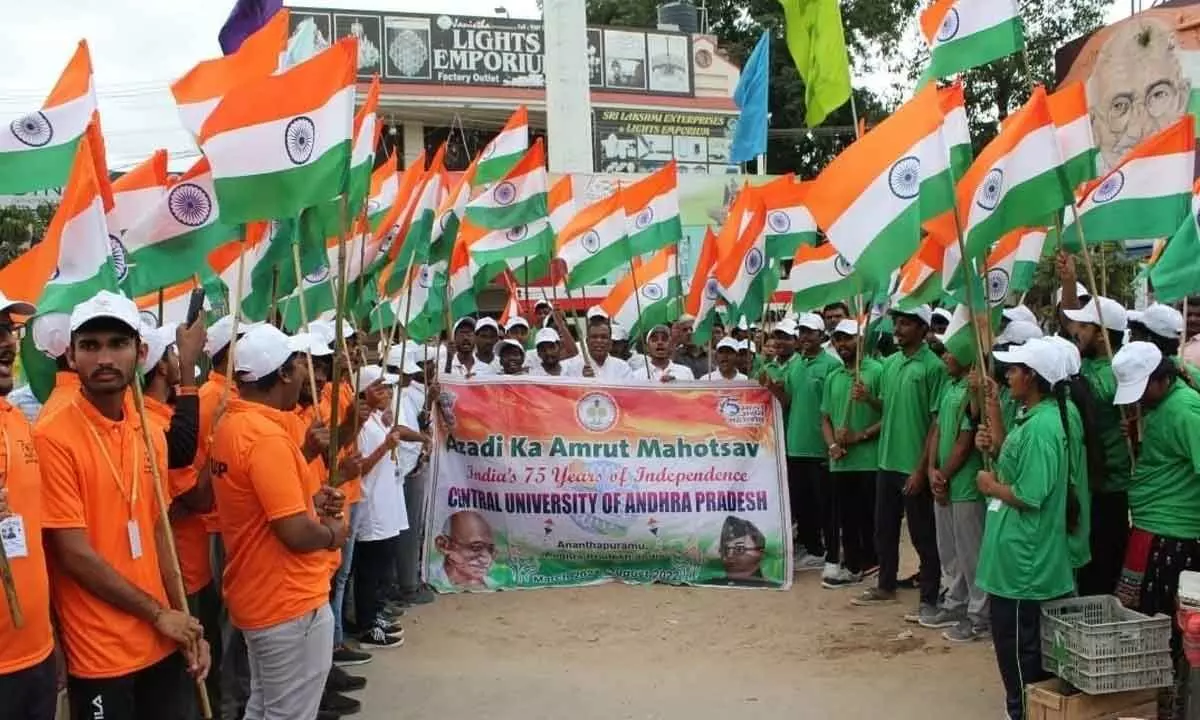Anantapur significantly contributed to India's freedom movement

Central University students displaying patriotism with slogans glorifying 75 years of Independence, in Anantapur on Sunday
- A M Linganna of Shira town in Karnataka in 1942 participated in freedom movement spearheaded by leaders like Kalluri Subbarao and Chakravarthi Rajagopal of Chennai in Rayalaseema region
- Linganna also set up Seva Ashram on the outskirts of his village in Parigi mandal, which also served as a secret meeting place for the freedom movement
Anantapur-Sathya Sai: A galaxy of freedom fighters in the undivided district greatly contributed to the freedom movement. Mohandas Karamchand Gandhi too participated in padayatra and participated in meetings in Tadipatri and other parts of the district. He appealed to wealthy patriotic leaders in the district to contribute their might to meet the movement expenses.
A M Linganna of Shira town in Karnataka in 1942 supported freedom movement spearheaded by leaders like Kalluri Subbarao and Chakravarthi Rajagopal of Chennai in Rayalaseema region. He established Seva Mandiram, an NGO to serve as a camouflage of his freedom movement. He also visited Sabarmathi Ashram of Mahathma Gandhi in Gujarat and confered with Gandhi on joining hands with him but Gandhi advised him to stay where he is and strengthen freedom movement in the district. He returned home and built the Seva Ashram on the outskirts of his village in Parigi mandal. The Seva Ashram served as a secret meeting place for the freedom movement. He used his NGO activities as a shield for his freedom movement activity. The Seva Ashram also operated as a school which also served freedom movement interests.
Another stalwart in freedom struggle was Keshav Pillai, who established education institutions in Gooty, Rayadurgam and Anantapur. These schools helped advance freedom struggle in 1929. He also organised secret meetings of leaders in his school campuses and even donated liberally for the movement cause.
Another noteworthy incident that happened in 1946 was the destruction of a bridge by the people at Kottalapalle in Bidapanakallu mandal to prevent diversion of forest wealth by the British from Anantapur to Bellary. The British imposed a fine of Rs 5,000 on the village population responsible for Bridge destruction. The people collected the money and paid the penalty. After India attained Independence, the money was returned to the village panchayat by the government. The people used the returned money to build a primary school building.
Chenappa of Apracheruvu in Battalapalle mandal was a young turk, who inspired by the speeches of Gandhi joined the freedom movement in 1930. He spread the Quit India movement to every nook and corner of the district. He wore only Khaddar garments and addressed villagers from his village Rachabanda. His fiery speeches attracted attention of British soldiers and he was arrested by the British in January 25, 1941 and sent to Bellary jail. Attracted by Acharya Vinobhabhave land movement, he donated some of his lands to the movement.
Damodar Singh of Shirigadodli village in Gummagutta mandal in the district also inspired many in freedom struggle. He was a Hindi pandit in Arabic school in Rayadurg. Inspired by the speeches of Gandhi, he too joined the Quit India movement and he was jailed by the British in 1942. Singh was an excellent cook. He cooked tasty dishes in the jail for all the freedom movement leaders lodged in the jail. In 2000 he died in a road accident in Adoni in Kurnool district. He was given the Freedom Fighters Award by the then President of India K Narayan and chief minister Nara Chandrababu Naidu.
During the freedom movement in the 1920's journalists and newspapers in the district contributed richly for the advancement of movement.
During 1923-38 journalists from the district, Pattipati Rangan Naidu, Midathala Chennabasappa, Kalkuri Subbarao, Athmaramappa and V Sundaramma contributed greatly for passing on the leaders messages to people through multiple newspapers like Vijayavani, Rayalanadu, Mathru Seva and Pinakini. Leaders of those days Neelam Sanjeeva Reddy, Vidwan Vishwam, T Nagi Reddy, Neelam Rajasekhar Reddy, Sadashivan, Nallappa and others teamed up to run a secret newspaper Akashavani.
Another patriot Bhadkar Keshavaiah trained in the Gandhi Ashram spearheaded the Salt Sathyagraha movement in 1930 in Anantapur. He established an educational institution in Sainagar in the town. He was brutally hit by lathis by the British soldiers. Running a school, he supported the freedom struggle. He contributed fiery articles denouncing the British in several newspapers.
Another fiery leader Peddagondi Kondappa of old town in the city jumped into the freedom movement after igniting to the patriotic speeches of Gandhi. In 1940, he participated actively in the Civil Disobedience movement. He was arrested by the British police for pelting stones on the collector office just when he was tying nuptial chord in his wedding ceremony. He received the award from the then President of India V V Giri.
The district has sweet memories of Gandhi visiting Hindupur and Pedawadugooru where people responded overwhelmingly to the appeal of Gandhi for contributions. The place where Gandhi addressed a meeting at Five Lanthers centre is today named as Gandhi Chowk in Hindupur. Gaganmahal in Penukonda which was used as an office by the Britishers was set ablaze by patriots K Ramachandraiah, P Lakshmi Narasappa, P Seshashayanam and Narayana Reddy who actively participated in the Quit India movement.

